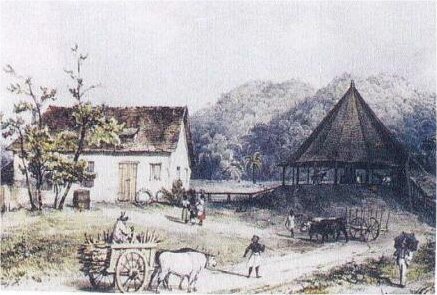by Michael
Anthony

Trinidad Express.......... January
5, 2000
In Trinidad we know of only half of the ten centuries, which
have passed in this second millennium after Christ, for our
recorded history began only in 1498, with the coming of Columbus.
Previous to that, the country was inhabited only by Amerindians,
and of their past we know nothing since they did not write.
We can only examine Trinidad after the end of the 15th century.
The 16th century continued to be a century of great silence,
but it was also the century when Trinidad began to change
from being a completely Amerindian island which the conquerors
called primitive, to a land where at least one town had been
established - San Jose de Oruna. That century could be said
to have ended in shambles, for the governor, Antonio de Berrio,
died on the mainland while seeking El Dorado; then the only
town, San Jose de Oruna, was burnt to the ground by Sir Walter
Raleigh, and the fact was that Trinidad was left almost as
it had been when that century began.
The 17th century did not make much of a difference either.
There was a succession of Spanish governors who came and spent
some time at the capital, San Jose de Oruna, and left, but
there was no Trinidad of progress on the horizon. However,
in 1687, something significant happened. The governor of 1682,
Diego Suarez Ponce de Leon, feeling that if the Amerindians
were not Roman Catholic like him they were heathens, called
on the King of Spain to send missionaries to convert the Amerindians
to Christianity.
The missionaries came in 1687, and in founding various missions
- about 20 in all - they were in fact founding villages. However,
in keeping with the 16th century, the 17th century also ended
with tragedy. In 1699 trouble broke out at one of the capuchin
missions - San Francisco de los Arenales, better known as
Arena. There, three priests were killed by the Spaniards:
"El massacre de Arena," or the Arena massacre. However, the
real massacre had taken place when the Spanish forces pursued
and killed hundreds of Amerindians in revenge for this incident.
The 18th century could be called the most crucial century
of the millennium, for this was the century, which saw Trinidad
get an active and vibrant population. The century had begun
rather slowly but the significant moment came in 1777 when
a French settler from Grenada, Phillipe-Roume de Saint Laurent,
was invited to Trinidad to see if he could settle here. Saint
Laurent was glad to come, hoping to get away, he said, from
British influence in Grenada.
Saint Laurent was invited here in a scheme by the Spanish
government to attract settlers to Trinidad in the hope that,
should it be attacked by the British, then fighting a war
in the Windward Islands, it would have a population with which
to defend itself.
Shortly after Saint Laurent arrived, he decided on his future
and the future of Trinidad. For he fell so much in love with
the island that he was determined to attract all the French
people in Grenada and the other islands to come and settle
in Trinidad. He drew up a document to show the governor how,
by Spain offering incentives such as the granting of land,
and relief from taxes, he would be able to attract thousands
of planters and their slaves, who would then open estates
and develop Trinidad.
The governor could not decide, nor could his superior, the
Intendant at Caracas, and so Saint Laurent decided to go to
Madrid to see the King of Spain. The King was so excited on
hearing Saint Laurent's plan that, in November 1783, he declared
a Cedula of population for Trinidad. This, in the main, is
what has given Trinidad its African population and its French
Creoles.
At the close of the 18th century the population of Trinidad
was about 20,000 people, more than half of whom were African
slaves. There were about 5,000 French planters, and the rest
were free blacks and coloureds. The capital, which had been
San Jose, moved to Puerto Espana.
This century also ended with tragedy, but this time for Spain.
On February 17, 1797, the British attacked Trinidad, and the
force from within, which was supposed to defend it, never
did any such thing. In fact it was hostile to Spain. The next
day Trinidad fell.
The 19th century, which began with British rule, saw violent
occurrences under the first governor Thomas Picton, the destruction
by fire of the former Puerto Espana (Port of Spain), and it
saw the long struggle of the slaves to be free. This freedom
came in 1838, and with the slaves turning away from the sugar
plantations; it saw the introduction of the East Indians in
1845.
Other highlights of the 19th century were the establishment
of a public education system in 1851 by Governor Lord Harris,
the introduction of electricity in 1895, and the tense struggle
for political reform.
When the last century of the millennium - the 20th - started
on January 1,1901, the country was poised for all sorts of
conflict and pain, change and progress. And it was a century
in which the hitherto 'subject' peoples were to come into
their own.......
 .
.